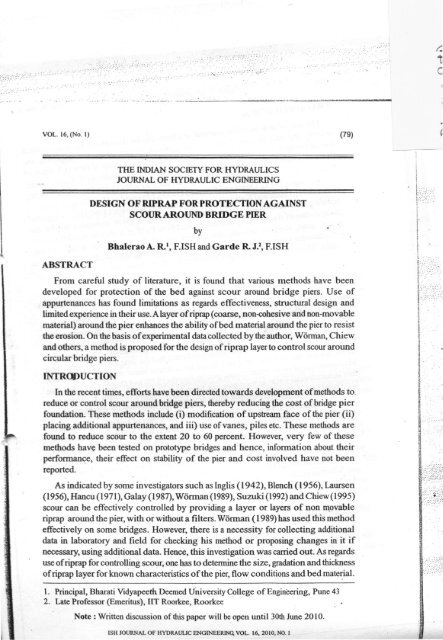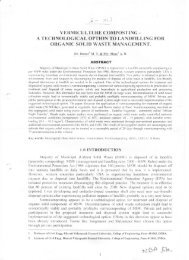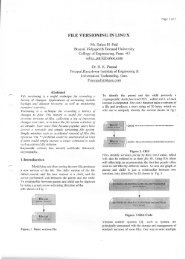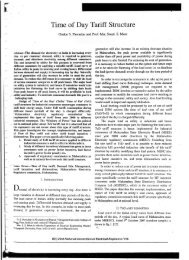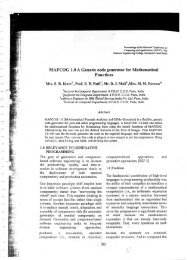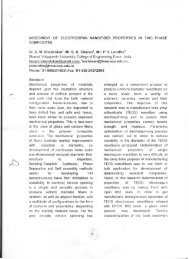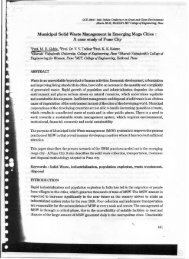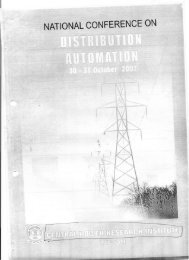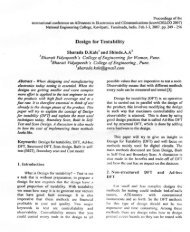DESIGN OF RIPRAP FOR PROTECTION AGAINST. SCOUR ...
DESIGN OF RIPRAP FOR PROTECTION AGAINST. SCOUR ...
DESIGN OF RIPRAP FOR PROTECTION AGAINST. SCOUR ...
Create successful ePaper yourself
Turn your PDF publications into a flip-book with our unique Google optimized e-Paper software.
.: '.' ..... 0.':'<br />
....::..: : '<br />
..... :<br />
.....:.'~ .<br />
..••. r,<br />
' .....<br />
:'."<br />
VOL l6, (No. l) (79)<br />
ABSTRACT<br />
THE INDlAN SOCIETY <strong>FOR</strong> HYDRAULICS<br />
JOURNAL <strong>OF</strong> HYDRAULIC ENGINEERING<br />
<strong>DESIGN</strong> <strong>OF</strong> <strong>RIPRAP</strong> <strong>FOR</strong> <strong>PROTECTION</strong> <strong>AGAINST</strong>.<br />
<strong>SCOUR</strong> AROUND BRIDGE PIER<br />
by<br />
Bhalerao A. R.t, F.ISH and Garde R. J.1, F.ISH<br />
From careful study of literature, it is found that various methods have been<br />
developed for protection of the bed against scour around bridge piers. Use of<br />
appurtenances has found limitations as regards effectiveness, structural design and<br />
limited experience in their use.Alayer of riprap(coarse, non-cohesive and non-movable<br />
material) around the pier enhances the ability of bed material around the pier to resist<br />
the erosion. On the basis of experimental data collected by theauthor, Worman, Chiew<br />
and others, a method is proposed for the design of rip rap layerto control scour around<br />
circular bridge piers.<br />
INTR~UcTION<br />
In the recent times, efforts have been directed towards development of methods to.<br />
reduce or control scour around bridge piers, thereby reducing the cost of bridge pier<br />
foundation. These methods include (i) modification of upstream face of the pier (ii)<br />
placing additional appurtenances, and iii) use of vanes, piles etc. These methods are<br />
found to reduce scour to the extent 20 to 60 percent. However, very few of these<br />
methods have; been tested on prototype bridges and hence, information about their<br />
performance, their effect on stability of the pier and cost involved have not been<br />
reported.<br />
As indicated by some investigators such as Inglis (1942), Blench (1956), Laursen<br />
(1956), Hancu (1971), Galay (1987), Worman (1989), Suzuki (1992)and Chiew (1995)<br />
scour can be effectively controlled by providing a layer or layers of non movable<br />
riprap around the pier, with or without a filters. Worman (1989) has used this method<br />
effectively on some bridges. However, there is a necessity for collecting additional<br />
data in laboratory and field for checking his method or proposing changes in it if<br />
necessary, using additional data. Hence, this investigation was carried out. As regards<br />
use of riprap for controlling scour, one has to determine the size, gradation and thickness<br />
of riprap layer for kno~ characteristics of the pier, flow conditions and bed rnate~aL<br />
1. Principal, Bharati Vidyapeeth Deemed University College of Engineering, Pune 43<br />
2. Late Professor (Emeritus), IlT Roorkee, Roorkee .•<br />
Note: Written discussion of this paper will be open until 30th June 2010.<br />
ISH JOURNAL <strong>OF</strong> HYDRAULIC ENGlNEERING; VOL. 16, 20 to, NO.1<br />
..<br />
I':.<br />
1 c
) ::<br />
;..•.....<br />
«-."<br />
- ....<br />
~ .<br />
'.'..<br />
(80)<br />
TWO APPROACHES<br />
<strong>DESIGN</strong> <strong>OF</strong> <strong>RIPRAP</strong> <strong>FOR</strong> PROTI:CTION <strong>AGAINST</strong><br />
<strong>SCOUR</strong> AROUND BRIDGE PIER<br />
VOL. 16, (No.1)<br />
The size of non-movable material in riprap can be determined by either critical<br />
velocity approach or critical shear stress approach. In critical velocity approach, the<br />
size of riprap (D) can be obtained relating it to average velocity of flow (U), depthof<br />
flow (Y) and difference in specific weights of sediment and ~ater (f1y s)' if one assumes<br />
that viscosity is not important. Investigators such as Ishbash (1935), Garde (1970),<br />
Bonasoundas (1973), Quazi and Peterson (1973), Maynord et al. (1989), Richardson<br />
et al. (1991), Garde and Kothyari (1995) Parola(1995), Chiew (1995) have suggested<br />
equations for computation of size of riprap. Most of these equations are for the<br />
computation of size of riprap in unobstructed flow.Further, it may be noted that when<br />
water flows, shear or velocity distribution around the bridge pier is affected and<br />
instantaneous values of these two parameters vary and much greater than time averaged<br />
values. These two aspects are not considered in these equations.<br />
Alternately one can specify that /). D in case of riprap layer should be less<br />
Ys 50<br />
than a specific value for it to be stable and control scour. Garde and Kothyari (1995)<br />
recommended this value as 0.03 for riprap in a channel. Here 'to is average shear<br />
stress in the channels equal to RS. However, in case of bridge pier, local shear around<br />
the pier is greater than the average shear stress in the channel. Assuming 'to is<br />
proportional to l.P, experimental evidence indicates that the time averaged local shear<br />
stress around the pier can be 3 to 5 times the average shear stress in the channel.<br />
Measurements of shear stress around pier by Hjorth (1975) and Darghi (1987) indicate<br />
that instantaneous shear around pier can be as high as 11 to 12 times 'to. These two<br />
facts need to be taken in to account while developing the method for design of riprap.<br />
As mentioned by Chiew and Melville (1989) the effect of sediment gradation is<br />
negligible when standard deviation ( (Jg) of riprap is less than 2. Hence, it is desirable<br />
to have standard deviation ( (Jg) of riprap between 2 and 3. Filter underneath the riprap<br />
layer is usually required to prevent leaching of base material, which takes place due<br />
to penetration of turbulence in the riprap layer. This takes place due to penetration of<br />
turbulence in the riprap layer. However, considering the difficulties in laying the filter<br />
layer, Worman (1989) has indicated that two or more layers of graded riprap can be<br />
designee in such a way that provision of filter is not needed. This approach is adopted<br />
here.<br />
BRIEF REVIEW<br />
Generally, the size of riprap is determined by using one of the equations available<br />
for critical velocity. Worman (1989) has used Ishbash (1935) equation in which<br />
diameter of riprap D is expressed as function of critical velocity as given below.<br />
ISH JOURNAL <strong>OF</strong> HYDRAULIC ENGINEERING, VOL. 16.2010, NO.1
I<br />
VOL. 16, (No.1) <strong>DESIGN</strong> <strong>OF</strong> <strong>RIPRAP</strong> <strong>FOR</strong> <strong>PROTECTION</strong> <strong>AGAINST</strong><br />
<strong>SCOUR</strong> AROUND BRIDGE PIER<br />
u, =O.8sl2g p,;p D<br />
Hereu =2U.<br />
c<br />
On the basis of small-scale experiments, Suzuki (1992) suggested that the thickness<br />
(T) of the riprap be obtained from Eq. (1).<br />
where r., and 'to are dimensionless critical shear stress given by (~ 1"~ J and<br />
r, 50<br />
~Ys D5~<br />
respectively. Kulkarni (1993) has recommended that, thickness of riprap<br />
(T) can be obtained from the equation.<br />
U 2<br />
T=--:--~<br />
2 g (:; -IJ (3)<br />
(81 )<br />
(1)<br />
(2)<br />
,<br />
l. •<br />
j. ,<br />
t<br />
l.<br />
r<br />
I .<br />
. ':'-:----0.'-'<br />
v-, :.: -. :.:<br />
where U is average velocity in unobstructed flow. This equation is to be used for<br />
protection of bed and banks in the river. On the basis of analysis of the laboratory data<br />
collected, Worman (1989) has proposed the following equation for thickness of riprap<br />
as, ...<br />
"--- -.<br />
where T is thickness of riprap, p is coefficient of friction for turbulent flow, CD is the<br />
drag coefficient of particle of bed material and n is porosity the value of which is<br />
taken as 0.38. Inserting values of p, PS' Pf' Co and n, this equation reduce to<br />
( U ~6(~)<br />
2<br />
)<br />
gT c DI5<br />
If (d85 ) > 0.15<br />
, DI5<br />
It may be mentioned that in Eqs. (4) and (5), Worman uses U= 2U o where U,<br />
average velocity in unobstructed channel, in order to account the fact that scouring<br />
ISH JOURNAL O~HYDRAULIC ENGINEERING, VOL. 16.2010. NO.1<br />
(4)<br />
(5)<br />
~ .-'<br />
.,<br />
:.. -'~.<br />
.~:- -." :-:<br />
." .... -<br />
.. -.: :.: :. :-,:,:::,:~:",:.- ':::;':~::.::::::':
(82) <strong>DESIGN</strong> <strong>OF</strong> <strong>RIPRAP</strong> <strong>FOR</strong> <strong>PROTECTION</strong> <strong>AGAINST</strong><br />
<strong>SCOUR</strong> AROUND BRIDGE PIER<br />
VOL. 16. (No. I)<br />
velocity near the bridge pier is greater than average velocity in unobstructed flow.<br />
U 2<br />
d<br />
Figure 1shows variation of-<br />
T<br />
and D S5<br />
• when dgs1D is less than 0.1. Onthe basis<br />
15 g IS<br />
of short duration tests, Chiew (1995) plotted the graph of UI U c against TID 50 and has<br />
shown separate regions in which riprap around bridge pier had failed and in intact<br />
condition. Refer Fig. 2.<br />
Recently some work has been done by Kothyari, Hager and Oliveto (2007) to<br />
predict densimetric particle Froude number at incipient scour condition near bridge<br />
pier as a function of Rld 50 • (dsidI6) and geometry of obstruction.<br />
EXPERIMENTAL PROGRAMME<br />
Keeping in view' the information available, the problem posed for the study was to<br />
develop a method to determine size and thickness of the riprap, which willprotect the .<br />
bed around the bridge pier from scour. For the bed material and riprap size chosen,<br />
three types of experiments were conducted in 0.30 m wide, 0.60 m deep and 10 m<br />
long tilting flUII1ein the Fluid Mechanics Laboratory of CivilEngineering Department<br />
of Bharati Vidyapeeth University. Experiments were related following conditions<br />
/gT<br />
1<br />
0.8<br />
0:6<br />
0...•<br />
0.2<br />
0<br />
fi ~<br />
/ 0<br />
/V<br />
~<br />
,<br />
,<br />
,<br />
O· 0.05 0.1 0.15<br />
FIG. 1 THICKNESS <strong>OF</strong> <strong>RIPRAP</strong> - WORKMAN RELATIONSHIP<br />
ViDc<br />
1<br />
0.8<br />
0.6'<br />
004<br />
0.2<br />
0<br />
F
I<br />
II<br />
VOL. 16, (No.1) <strong>DESIGN</strong> <strong>OF</strong> <strong>RIPRAP</strong> <strong>FOR</strong> PROTECfION <strong>AGAINST</strong><br />
(83)<br />
<strong>SCOUR</strong> AROUND BRIDGE PIER<br />
.,<br />
1. Incipient Scour of bed material around the pier<br />
2. Incipient scour of riprap of different size and thickness<br />
3. Scour with riprap protection.<br />
Over 150 runs were conducted using circular pier of 50 mrn diameter under clear<br />
water condition. Table 1 gives standard deviation, size of bed and riprap material<br />
tested in the experiments. The circular ring with engraved marking in nun was used to<br />
lay riprap of appropriate thickness and flush with original bed level, Bed material of<br />
predetermined thickness was removed from scoured area, weighed and riprap of same<br />
weight was then slowly added to the scour hole and levelled to the undisturbed bed<br />
level.<br />
In addition to the data collected in the present study, data collected by Knight<br />
(1975), Dey (1995), Chiew (1995), Melville (1997),ha:ve also been used for<br />
determining DIU c for incipient scour and those by Worman (1989) and Chiew (1995)<br />
for size and thickness of riprap layer. Worman (1989) had used three bed materials of<br />
median diameter 0.17,0.36 and 0.78 mm and five ripraps of size varying from 8 to 48<br />
mm. Depth of the flow varied from 300 to 400 mm whereas Chiew (1995) used bed<br />
material of mean size 0.96 mm and three riprap of size 2.60, 4 and 4.85 mm.<br />
TABLE-l<br />
CHARACTERISTICS <strong>OF</strong> BED AND <strong>RIPRAP</strong> MATERIAL<br />
(pRESENT STUDy)<br />
ANALYSIS <strong>OF</strong> DATA<br />
Bed Material Riprap Material<br />
d so (mm) 0'& Dso(mm) O'g<br />
0.20 2.45 1 1.37<br />
0.27 2.69 2. 1.90 .<br />
0.36 1.28 3 2.36<br />
0.40 2.53 4 2.50<br />
0.50 2.63 5 2.66<br />
0.68 2.73 8 1.58<br />
Limiting values ofUfUcfor Incipient Scour<br />
The critical velocity at which sediment of a given size will just move in an<br />
un~bstructed uniform flow was obtained by combining Shields' and Yalin-Karman<br />
relationship with Karman-Prandl's equation of Diu. in hydro-dynamically smooth<br />
and rough channels. Analyzing the generated data, following type of equation was<br />
obtained.<br />
(:;::X~:~~~~P:~::;:;'~~1::r~7:??·:·;·'·~:·?::;·::;·:·;<br />
>::. :::;:.:-:;~:: ;.::::~:::::. :':":"::~,, ::.' ~=:' . .'::'"'::'~:<br />
ISH JOURNAL <strong>OF</strong> HYDRAULIC ENGINEERING, VOL 16,2010, NO. I<br />
:.:;.:.;:.:~-y.:..:>~.?::~.:':;::::;:::::;:.::.:.:...;:::, ..... :..... : .. :.,,: ::.:':.::.::,::.. ::: ::.:::.: ... :;::::.... :.::::'::: ::::-, :::;: .. :.: '.: -:: : .::.:<br />
..>:-....~ .':.~-~".~: ~;~:~:.':' :'~..-::;
f.J~~~~~~~~i::S*/:'~~~':':''i:;;:;::~·:::;:;:);:j;:
~~~'"...':.,;,s.':"":';:~~~"'- .•.. " :..-~....:...:-.- ..#-<br />
•••••• '" .". :.;~'"__=<br />
...•~ .. _. ·_'·-'::~=--_'~'''''':~''''~':''''_'~''':'''·'·''-'/:-J';.'~.r~ ..<br />
o t<br />
)<br />
IS<br />
~.<br />
n<br />
It ...,<br />
II<br />
r<br />
e<br />
r<br />
n<br />
e<br />
I,<br />
1 .<br />
e<br />
s<br />
f<br />
e<br />
,.<br />
f<br />
I<br />
:.;:~~·:~:::~~~~~~:~>r~~;p7:~.:"-.~~.-<br />
-.<br />
/"j ·.·.·0·.·.· - -.: -~::<br />
VOL. 16, (No. I) <strong>DESIGN</strong> <strong>OF</strong> <strong>RIPRAP</strong> <strong>FOR</strong> <strong>PROTECTION</strong> <strong>AGAINST</strong><br />
<strong>SCOUR</strong> AROUND BRIDGE PIER<br />
.\ TABLE-3<br />
UlU c AND CORRESPONDING SHEAR AT PIER<br />
S.N Name of the Investigator UIU 't p = M 't oc<br />
c<br />
Shear Stress by velocity Measurement<br />
I Nicollet (1977) 0.42 5<br />
Circular PierRounded nosed Pier 0.50-0.65 3<br />
2 Lee Jong (1973)<br />
Circular pier without 0.40 6.25<br />
attachment Round nosed and 0.50 4.00<br />
Rectangular<br />
3 Bressure and Roudkivi (1977) 0.5 4<br />
4 Chiew (1995) 0.3 11<br />
5 Melville (1999) 0.34 8<br />
6 Dey (l993) 0.475 4<br />
7 Present 0.438 5<br />
Shear Stress by Preston Measurement<br />
8 Hjorth (1975) - 12<br />
9 Melville (1975) - 3.5<br />
10 Darghi (1987) - 3.5<br />
Studies of Einstein and E1. Sarnni (l949), Gessler (1967) and Little Mayer (l972)<br />
have shown that the lift as well as shear at the bed fluctuates in turbulent flow, and<br />
follows Gaussian distribution as an approximation with standard deviation «J') in<br />
dimensionless form varying from 0.45 to 0.57. Therefore, the maximum shear stress<br />
near the pier can be 'tpmax = (Tp + 3 x 0.45Tp) = 2.35'tp. Here, value of o assumed is<br />
0.45. Therefore, riprap layer can be disturbed when 'tpmax-2.35 (5'[) = 12 'to'<br />
Patel and Raga Raju (1999) in their analysis of critical shear stress of non uniform<br />
material have recommended the use of characteristic size of bed material D a' which<br />
is given by D g x o g instead ofD so to for account non- uniformity of sediments. Here,<br />
D g isgeometric median size of riprap and og geometric standard deviation. Therefore,<br />
to prevent scour around the bridge pier , the size of the riprap material D can be<br />
g<br />
calculated as,<br />
D = 12'[0<br />
a flys t. co<br />
.... "'; .-: ,".":-." ."::. . ., ' ..<br />
"<br />
ISH JOURNAL <strong>OF</strong> HYDRAULIC ENGINEERING, VOL. 16,2010, NO.1<br />
(85)<br />
(8)<br />
l,if;<br />
.<br />
i,<br />
..<br />
I,
i I<br />
1<br />
(86)<br />
where n, =Dg xDg<br />
<strong>DESIGN</strong> <strong>OF</strong> <strong>RIPRAP</strong> <strong>FOR</strong> <strong>PROTECTION</strong> <strong>AGAINST</strong><br />
<strong>SCOUR</strong> AROUND BRIDGE PIER<br />
VOL. 16, (No.1)<br />
As an approximation, for Gaussian distribution Dg and D(J assumed as D50 and D84<br />
of rip rap mixture respectively. Further, Patel and Ranga Raju (1999) have given 't. co<br />
as a function of ag' This relationship is used to obtain 't. co for corresponding given<br />
magnitude of ag of the material used by Worman, Chiew and in present study.For the<br />
determination of size of riprap, one can choose the magnitude of ag and substitute the<br />
corresponding value of 't.c(J in Eq. (9) and can find average size of riprap.<br />
Size of the riprap calculated using Eq. (9) for Worman data was found to be 50 to<br />
96 percent higher in comparison with size of the riprap used in his experiments.<br />
Worman suggested use ofIshbash equation for the determination of size of the riprap<br />
taking local velocity (u) around the pier as twice the average velocity in unobstructed<br />
flow (u=2U). Size of the riprap computed using Ishbash equation (with u= 2U) for the<br />
data collected by Worman was also found to be 25 to 50 percent higher than those of<br />
used in his experiments.<br />
Further, data collected by Worman and Chiew were analyzed for computation of<br />
non-dimensional critical shear stress ('t.J for incipient scour of riprap and it was<br />
found that average value of 't. c as 0.00174 and 0.013 respectively. In the present<br />
study nms were also conducted for incipient scour of riprap and average value of<br />
non-dimensional critical shear stress (-r.J for riprap of given size was found to be<br />
0.0088. Further, in the present study 41 runs were observed either with no scour or<br />
with negligible scour. The non-dimensional critical shear stress (-r.J in these scour<br />
runs was found to vary from 0.003 to 0.09 giving an average value of 0.028. Table 4<br />
gives these details.<br />
TABLE-4<br />
NON-DIMENSIONAL CRITICAL SHEAR STRESS<br />
S.No. Name of the Investigator t., (J'c<br />
1 Worman (1989) 0.00174 1.18 -1.38<br />
2 Cfiiew (1995) 0.136 1.25 -1.27<br />
3 Present- runs for incipient scour of riprap 0.0088 1.36-2.67<br />
(analysis)<br />
4 Present - zero scour run with riprap 0.028 1.36 - 2.67<br />
ISH JOURNAL <strong>OF</strong> HYDRAULIC ENGINEERING, VOL. 16,2010, NO.1<br />
v-,<br />
.........<br />
-, , ::...... "<br />
..... ;"...'- ", :.::.:::: .<br />
(9)<br />
I I<br />
i<br />
I iI<br />
I
.....<br />
. . ..<br />
..... -.. - - ..'~ , .•................•<br />
VOL. 16,(No.1) <strong>DESIGN</strong> <strong>OF</strong> <strong>RIPRAP</strong> <strong>FOR</strong> <strong>PROTECTION</strong> <strong>AGAINST</strong><br />
<strong>SCOUR</strong> AROUND BRIDGE PIER<br />
From this table, it is evident that Worman's method over predicts the size by about<br />
5 to 8 times, and Chiew's method gives 2 times larger size than that of observed in the<br />
experiments, where as in case of data collected in the present study it is 1.6 times<br />
(average) larger in comparison with observed size of rip rap.<br />
ANALYSIS <strong>OF</strong> <strong>RIPRAP</strong> TmCKNESS<br />
For studying the effectiveness of riprap in reduction of scour, the parameter C. =<br />
C a /C b has been calculated. Here C b is the value of constant obtained ill Kothyari et al.<br />
(1992) equation for scour in clear water studies, for non-uniform base material (Eq.<br />
(10».. .<br />
(87)<br />
(10)<br />
C is value of C when riprap was used and some scour was observed.<br />
~<br />
The ratio of C/C b called C. takes in to account the effect ofU, Y, opening ratio a<br />
and /1.Ys on scour and hence, it should be function of D,= dsJDso and T. = T/3cr. Dso<br />
related to rip rap layer and bed material size only. Thickness of riprap layer can be non<br />
dimensionalised by maximum size of the riprap material, which can be expressed as<br />
3. Dso. Anew term therefore, introduced and expressed as T. =T/3cr a D so ' where T<br />
is the thickness of the riprap layer, cr is the standard deviation of riprap mixture<br />
a .<br />
given by ~D84 /D 16 and Dso is median size ofriprap mixture. lfthe sizesin riprap are<br />
distributed normally, 99.73 percent values will be within the range ofD so± 3c •. Hence,<br />
3cra Dso is as good as maximum size of the riprap mixture when D100 is not known.<br />
The experimental data having eight ranges of D. starting from 0.045 and 0.78<br />
were plotted as C/C b Vs T. for respective range ofDiand the equation between them<br />
is obtained as<br />
C a _ C = 0.5 D~·98 T.- 2 . 50<br />
C b - • (ll)<br />
By assuming that at a value of C. as low as 0.05, riprap around the bridge pier will<br />
be stable. Hence, this equation can be solved for with this value for determining the<br />
thickness of riprap. Data collected by Worman (1989) and Chiew (1995) are used for<br />
the comparison of the thickness of riprap layer computed using Eq. (10). Figure 3<br />
shows the thickness of riprap layer used by these investigators in their experiments<br />
for zero scour condition and thickness computed using Eq. (11). The plot shows 86%<br />
of Worman's data points and 68 % ofChiew's data points fall within the error band of<br />
. '\<br />
ISH JOURNAL <strong>OF</strong> HYDR,AULIC ENGlNEERING, VOL. 16,2010, NO. 1_<br />
':.'<br />
-<br />
'-"'.-<br />
,:.: :.:<br />
.:: .<br />
;;.....
l~':"'2C":;'§;{k)!"i;,,:dX'6B'~k;X~J/%#iiMtiiiW;i;l1~li.~1:i1t{l~'i;';';~Jf.~<br />
>:~<br />
~#<br />
s: ..<br />
.,<br />
.".<br />
:<br />
/ .,'<br />
e:<br />
":.:<br />
f:-<br />
"':'.":<br />
: ..<br />
.:,<br />
,..<br />
.'0'<br />
(88) <strong>DESIGN</strong> <strong>OF</strong> <strong>RIPRAP</strong> <strong>FOR</strong> <strong>PROTECTION</strong> <strong>AGAINST</strong><br />
<strong>SCOUR</strong> AROUND BRIDGE PIER<br />
VOL 16.(No, 1)<br />
-v<br />
± 50 %. Data collected in no scour runs of present study are also plotted in the same<br />
figure. It is observed that the 75% of data collected in present study fall in the error<br />
band of ± 50 %.<br />
Thickness of riprap provided should also be economical. Blench (1957) suggested<br />
that thickness of riprap for bed protection may be three times the largest size of the<br />
stone in a mixture (DI~. Figure 4 shows the comparison between TlDloo observed<br />
and computed.<br />
If Eq. (11) is used to compute the thickness of riprap for Worman's and present<br />
data. thickness of riprapcomputed isfound to be orderone to three times D 100; however.<br />
it is four to five times that of D IOO in case of data collected by Chiew, Thickness of<br />
riprap layer using Worman and present data are found appropriate. however, it is<br />
slightly higher in case Chiew's data. In Worman's data the flow conditions, the<br />
characteristics of riprap, bed material and thickness of riprap used were pertaining to<br />
the observed "no scour" condition. In Chiew's data, the flow conditions given were<br />
intended for intact andfailed conditions of riprap. Average of flow data corresponding<br />
to intact and failed condition has been used in the present analysis to verify the Eq.<br />
(11). Theflow conditions pertaining to condition ofriprap described as intact. observed<br />
in his experiments may not be corresponding to the true Uno scour" condition. This<br />
could be possible reason for computed thickness of riprap found higher than observed.<br />
Line of Agreement.<br />
1000<br />
'.' tOO<br />
','<br />
..,<br />
--<br />
~<br />
I ••<br />
...<br />
to<br />
r<br />
I-<br />
, , ,<br />
, ,<br />
, ,<br />
,<br />
.'<br />
, ,<br />
Line of Agreement<br />
,<br />
, ,<br />
, , , , , ,<br />
, , ,<br />
, ,<br />
, , ,<br />
,<br />
~' _;)1 l"- I"'/Cl<br />
" B-' A,<br />
i-" ,6' ••<br />
,.0 ••<br />
,.111<br />
0<br />
1 10 100 1000<br />
AG. 3 THICKNESS <strong>OF</strong> <strong>RIPRAP</strong> (PRESENT METHOD)<br />
ISH JOURNAL <strong>OF</strong> HYDRAUUC ENGINEERING. VOL. 16, 2010. NO, 1
'. 1)<br />
ne<br />
or<br />
xi<br />
Ie<br />
d<br />
It<br />
. .,<br />
f<br />
VOL. 16, (No.1)<br />
<strong>DESIGN</strong> <strong>OF</strong> <strong>RIPRAP</strong> <strong>FOR</strong> <strong>PROTECTION</strong> <strong>AGAINST</strong><br />
<strong>SCOUR</strong> AROUND BRIDGE PIER<br />
Incipient Scour of Bed and Riprap Material<br />
The value of UfU c near the circular bridge pier in present study varied from 0.3 to<br />
0.65 and authors recommends it as 0.438. When bed material around the circular<br />
bridge pier starts just moving, the value of UfU c is 0.438.<br />
Assuming the 'to alP, and corresponding fluctuations in the shear/velocity around<br />
bridge pier, authors found that maximum value of instantaneous shear stress near the<br />
bridge pier is about 12 'to. Size of the riprap can be calculated using Eq. (9) with (Jg of<br />
riprap between 2 to 3.<br />
1·<br />
,,"<br />
10010-<br />
,<br />
,<br />
,<br />
,<br />
,<br />
+lS t>~p<br />
, .'<br />
,<br />
, ,<br />
"I
(90) <strong>DESIGN</strong> <strong>OF</strong> <strong>RIPRAP</strong> <strong>FOR</strong> <strong>PROTECTION</strong> <strong>AGAINST</strong><br />
<strong>SCOUR</strong> AROUND BRIDGE PIER<br />
ACKNOWLEDGEMENTS<br />
The authors are thankful to the reviewers for their constructive comments.<br />
REFERENCES<br />
VOL. 16, (No.1)<br />
Bonasoundas, M. (1973). Flow Structure and Scour Problem at Circular BridgePiers.<br />
Report No.28, O. v. Miller Institute, Munich Technical University.<br />
Chiew, Y. M. and Melville, B. W. (1989). Local Scour at Bridge Piers with Non-<br />
Uniform Sediments. Proc. ofInst. Civ. Engineers, Part 2, 87, pp. 215-224.<br />
Chiew, Y. M. (1995). Mechanics of Riprap Failure at Bridge Piers. JHE, ASCE, Vol.<br />
-116, No.4, pp. 5-529.<br />
Darghi, B. (1990). Controlling Mechanism of Local Scour. JHE,ASCE, Vol. 116,No.<br />
. 10, pp. 1197-1214 .<br />
. Dey, S. (1997). Local Scour at Piers Part I Review of Development of Research.<br />
DSR, Vol. 12,No.2, pp. 2346.<br />
Einstein, H. A. and El Samni, S. A. (1949). Hydrodynamic Forces on a Rough W~ll.<br />
Review of Modem Physics, American Institute of Physics, VoL 21, No.3.<br />
Galay, V. 1. and Quazi M. E. (1987). River Bed Scour and Construction of Stone<br />
Riprap Protection in Sediment Transport Gravel Bed Rivers. John Wiley and Sons<br />
Ltd., pp. 353-382.<br />
Garde, R. 1. (1970). Initiation of Motion on Hydro Dynamically Rough Surface Critical<br />
- Velocity Approach. TIP, CBIP, New Delhi, pp. 271-282.<br />
Garde, R. J. and Kothyari, U. C. (1995). State of Art Report on Scour around Bridge<br />
Piers. IIBE, Mumbai.<br />
Garde, R. J. and Ranga Raju, K. G (2000). Mechanics of Sediment Transport and<br />
Alluvial Stream Problems NeW Age International. llIrd Edition.<br />
Gessler, J. (1973). Behavior of Sediment Mixtures in Rivers. Proc. ofIntemational<br />
Symposium on River Mechanics, Bangkok (Thailand) IAHR, pp. A 10-35.<br />
Hancu, S._(1971). Sur Le Calcu Des Affouillements Locaux Dans La Zone Des Piles'<br />
Du Pont. Proc. of 14 th Congress ofIAHR, Paris, France, 3, pp. 299-306.<br />
Hjorth, P. (1992). Studies on Nature of Scour. Bulletin, Series A, No. 46, Institute for<br />
Tknisk Vatternresursla"ra, Lund.<br />
Inglis, C. c., Thomas, A.' R. and Joglekar, D. V. (1942). The Protection of Bridge<br />
Piers against Scour. Research Publication No.5, CWPRS, Pune, pp. 35-38.<br />
Johnson, P. A. (1995). Comparison of Pier Scour Equations using Field Data. JHE,<br />
ASCE, Vol. 121, No.8, pp. 626-629.<br />
ISH JOURNAL <strong>OF</strong> HYDRAUUC ENGINEERING, VOL. 16,2010, NO.1
. I) VOL. 16. (No. 1) <strong>DESIGN</strong> <strong>OF</strong> RlPRAP <strong>FOR</strong> PROTECIlON ,<strong>AGAINST</strong><br />
<strong>SCOUR</strong> AROUND BRIDGE PIER'<br />
:5'.<br />
1-<br />
l.<br />
).<br />
I.<br />
I<br />
!<br />
i<br />
i<br />
I<br />
. . .<br />
. . . -. ~ . .<br />
_.-. ..-<br />
Knight, D. W. (1975). A Laboratory Study of Local Scour and Bridge Piers. Proc.<br />
XVI Congress of IAHR, Sao, Paulo, Brazil, VoL 2, pp. 243-250.<br />
Kothyari, V. C. et al. (1993). Scour around Bridge Piers (Theme Paper). National<br />
Workshop on Bridge Scour, CBIP, Waranashi.<br />
Kothyari, Ll.C; Hager, W. H. and Oliveto, G. (2007). GeneralisedApproachJorClear<br />
Water Scour a Bridge Foundation Elements. JHE ASCE.<br />
Lauchlan, C. S. and Melville, B. W. (1999). Pier Scour Counter Measures. Report<br />
No. 540, Department of Civil and Resource Engineering, The University of<br />
Auckland.<br />
Little, W. C. and Mayer, P. G. (1972). The Role oj Sediment Gradation on Channel<br />
Armoring. School of Civil Engg., Georgia Institute of Technology (U.S.A.), ERC<br />
0672.<br />
Maynord, S. T., Ruff, J. F. and Abt, S. R. 1(1989). Riprap Design. JHE, VoL 115,No.<br />
7, pp. 937-949.<br />
Melville, B. W. (1997). Local Scour at Bridge Sites. Report No. 117, School of<br />
Engineering, University of Auckland.<br />
Parola, A. C. (1993). Stability oj Riprap at Bridge Piers. JHE, ASCE, VoL 119, No.<br />
10, pp. 1080-1093.<br />
Parola, A. C. (1995). Boundary Stresses and Stability of Riprap at Bridge Piers. River<br />
Coastal and Shore Line Protections: Erosion Control Using Riprap and Armor<br />
Stone, John Wiley and Sons Ltd., pp. 149-156.<br />
Patel, P. L. and Ranga Raju, K. G. (1999). Critical Tractive Stress on Non Uniform<br />
Sediments. JHR, IAHR, Vol. 37, No.1, pp 39-58.<br />
Quazi, M. E., Peterson, A. W. (1973). A Methodfor Bridge Pier Riprap Design. Proc.<br />
FIrst Canadian Hydraulic Conference, Edmont, Canada, pp. 96-106.<br />
Richardson, E. v., Harrison, L. J. and Davis, S. R. (1991). Evaluating Scour at Bridges.<br />
Rep. No. FHWA-IP-90-0l7HESI8, Federal Highway Administration (FHWA),<br />
~ashington, D.C.<br />
Worman, A. (1989). Riprap Protection without Filter Layers. JHE, ASCE, Vol. 115,<br />
No. 12, pp. 1615-1630.<br />
NOTATIONS<br />
a. angle between axis of the pier and approach flow<br />
~ constant used by Worman<br />
Ys specific weight of sediment<br />
ISH JOURNAL <strong>OF</strong> HYDRAUUC ENGINEERING. VOL. 16. 2010. NO.1<br />
(91)


